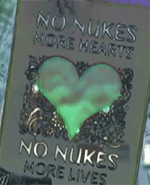 from Fairewinds Energy Education
from Fairewinds Energy Education
As the three year anniversary of the triple meltdown at Fukushima Daiichi just passed, our minds have been on the health of the Japanese people, in particular the children.
This week’s film is a reissue of a film we released last year featuring Ian Goddard and Fairewinds’ Arnie Gundersen discussing the risk of cancer in children in and around Fukushima prefecture.
The statistics are astounding especially for young girls.
For every year a young girl is the in the radiation zone 1 in 100 girls is going to get cancer due to their exposure from Fukushima. As each year passes it compounds, so if a young girl is there for 10 years, 10 out of 100 will get cancer.
The statistics are terrifying and the Japanese government has allowed families with young children to return to Fukushima prefecture.
Cancer Risk To Young Children Near Fukushima Daiichi Underestimated from Fairewinds Energy Education on Vimeo.
Hi Helen, We enjoyed you ABC, 1 on 1 interview, & recognise an amzing life you have carved out for your self. My Husband is Peter McNally. We were both born in Adelaide. in the early 1940’s. We operated a number of Health & Fitness centres from 1965 -2005, inc HQ @ Waymouth St, Light Square & @ Victor Harbour. In 1975 we moved the family to Brisbane while another family member continued in Adelaide. Having 7 Grand children we will follow your work, & hopefully will meet you when next in Brisbane. Kind Regards, Judy McNally
Nuclear radiation increases the risk of early death. As a medical problem the answer is to remove the nuclear radiation.
Geological movement and waves in the sea have been seen in Japan & are expected in the future. Fukushima was impacted by a predicted event, but systems failed to protect it.
The legacy of nuclear reactors is concentrated radiation. The short term benefit of electrical power is offset by long term unwanted radiation dangers.
This article shows the policy decisions made in past have left a high cost for the next generation.
It is only with blinkered vision that economist can ignore residual effects like making the planet less livable.
This is a gross distortion of facts.
First of all there the 1 in 100 rate is over a lifetime not over a year, additionally stating that 1 in 100 WILL get Cancer is absurd. This ratio is a measure of the absolute risk over a lifetime, so there is an increased cancer risk by 0.5% in real terms over a life time.
Secondly, the risk of a cancer occurring has risen to 1.25% from a background 0.75% already.
Thirdly this figure is for thyroid cancer only. The thyroid uses iodine to produce hormones in the body so is most affected by the release of radiation, namely iodine-131.
The prospect of staying in one location and this risk accumulating is a basic misunderstanding of mathematics. How can a probability of getting cancer that stands a 1 in 100 over a lifetime increase? Also the statement suggests that if one young girl stays in the area, then the absolute risk of the entire population increases to 10%, this is impossible